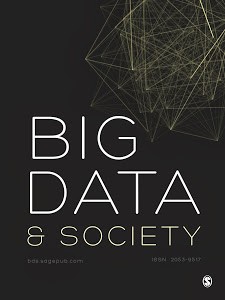WSI Distinguished Lecture by Prof. Evelyn Ruppert
By Digichamps Sylvian Jesudoss and Elena Tsarkova
On the 22nd January at the University of Southampton, there was a fantastic opportunity to attend the first WSI distinguished lecture of the year by Evelyn Ruppert, Professor at Goldsmiths University of London. She is also editor-in-chief of a new journal titled “Big Data and Society” and dedicated her lecture to “Reflection on Big Data and Society: visualizing an emerging field”.
Professor Evelyn Ruppert chose an interesting way to structure her presentation. She used the logo of the journal “Big Data and Society” to draw parallels on the issues related to visualization of big data.
Intrigued? Yes, the logo of “Big Data and Society” (shown below) is indeed a fascinating experiment by the team and it showed how important are some of the concerns in the broader discussions with respect to visualization of big data. The logo represents the different themes and subjects that are being researched in the realm of big data. It is the network diagram representation made by the co-word analysis of distinct keywords in various social science journals. The connections represent the frequencies in which a particular keyword is employed in relation to another keyword in the same article. It was indeed absorbing to understand how they came up with that diagram. The logo will eventually become a dynamic visualization of diverse themes and relationships that readers can play with on the journal’s website.
One of the issues that she put forth was what constitutes big data? The current definition deals with 3 Vs of big data – volume, velocity and variety whereas the journal tries to deal with the relations between the different sets of data practices. The relations include social relations (new ways of connecting in a social ways), method relations (relations between actors and how they connect), data relations (relations that people are becoming aware of in daily life) and research relations (relations between academic research and data subjects).
The second issue she discussed was the social life of big data and how the journal will allow the authors to dynamically check the different keywords or related keywords that other authors are using. This might encourage the authors to come forward with issues that dominate the subject. The third concern she came up with is the instability in the visualization criteria and fragility in the minor alterations that can be done to the design.
She also discussed the critiques that are made against network diagram. One was that network diagrams lack specificity and the other one is that they are spatial with respect to patterns and it privileges over other properties. And she defended why network diagrams, although simple, are currently needed for the visualization of big data.
Professor Evelyn’s lecture was an eye-opener with respect to the concerns of visualization in an emerging field like big data. The talk was engaging as she drew parallels with the journal and how they are going about envisaging the data they are collecting.
Before the presentation started all guests had a chance to meet each other in a hall where MSc students from the University of Southampton placed posters they created about a wide range of web science topics and guests had a chance to discuss these topics with the students.
Among many interesting posters it’s possible to highlight works dedicated to addressing the following questions:
1. Why people show different behavior online and offline?
Taekyun Kim considered the question from two different perspectives: psychology and computer science. From a psychological point of view, scientists see that people are more brave and open in communication online as there are no psychological boundaries. Also, users don’t feel guilty as they think it’s virtual space, they show their personality easily, which can be more usually hidden in the real world.
https://twitter.com/letsarkova/status/558320726621839361
2. Social media and how it works for banking business.
Dola Majekodunmi discussed an interesting topic about connections between social media and banking. She considered how companies use social media for solving different tasks such as managing customer relationships and brand reputation. She also outlined how communication between banks and their customers has changed. In Nigerian banks, communication has switched from traditional visiting a branch or telephone banking to using social media for solving problems.
https://twitter.com/letsarkova/status/558319400403890177
3. How can the Web improve political processes?
Gefion Thuermer discussed how the Web influences politics and decision making among people, how people gather information nowadays and what role social media plays.
https://twitter.com/Sylvianism/status/558315897526697984
https://twitter.com/letsarkova/status/558318478625890305
https://twitter.com/Sylvianism/status/558319446461530113
https://twitter.com/Sylvianism/status/558320536682762240

